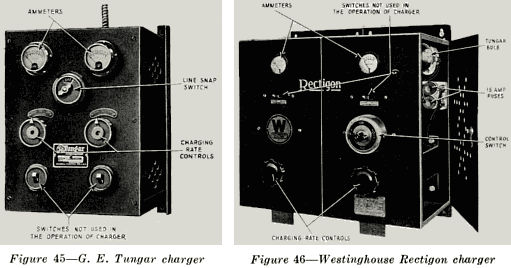In case the bulbs do not light when the AC line switch is closed and the snap
switch on the charger is in the "On" position, look for blown fuses in the AC line circuit.
If the fuses are O.K. and there is AC power available at the panel, the
trouble may be due to dirty contacts in the bulb sockets or they may be loose in their
sockets. The socket contacts should be kept clean and the bulbs should be kept securely
screwed into their sockets at all times. If this is not done the solder may melt out of the
center socket-contact and cause trouble.

If the bulbs light but the ammeters do not show current with all switches in their
proper positions for charging, check the fuses in the Tungar unit. These are accessible by
opening the left-hand side door.
Use only 15 ampere fuses when making a replacement.
If the regulating switches are hard to turn, it is a good plan to lubricate the contacts
and switch rider with a small amount of vaseline. This will also prevent the switch
contacts from corroding.
The operation of the Tungar shown in Figure 45 is the same as the one just
described. The panel of this Tungar has two extra snap-switches, which are not used in
the operation of the charger.
The Rectigon charger shown in Figure 46 is similar to the Tungar just described
except in the arrangement of the equipment. It also has two switches not used in
the operation of the panel. One position of each of these switches is marked for "1 to 8
Batteries". They should always be kept in this position.
A spare Tungar bulb should always be kept on hand, and should be tested for at
least one complete charge before being placed in reserve.
Printed in U.S.A. - Copyright 1930 RCA Photophone, Inc.
8
